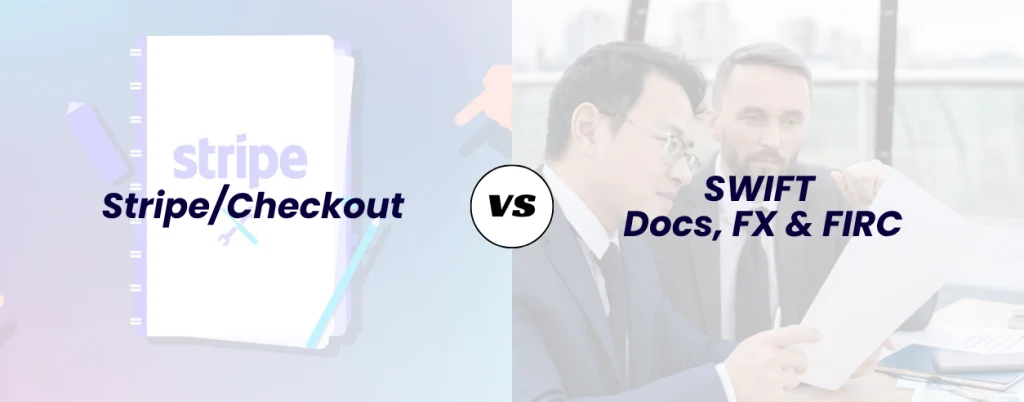Running a SaaS business from India that serves global customers means navigating one of the most complex payment ecosystems in the world. Unlike traditional export businesses with predictable invoice cycles and standard payment terms, SaaS operations deal with subscription complexity that creates unique challenges: midnight trial conversions, mid-cycle plan upgrades, prorated billing adjustments, failed payment retries, and refund processing—all while maintaining compliance with India’s export documentation requirements and optimizing foreign exchange realization.
After spending over fifteen years managing export finance operations and RevOps for SaaS companies scaling from startup to enterprise, I’ve learned that the choice between modern payment processors like Stripe and traditional SWIFT banking isn’t just about conversion rates or transaction fees—it’s about building financial infrastructure that can handle subscription complexity while maximizing INR realization and maintaining regulatory compliance. The wrong choice can cost you thousands in hidden FX spreads, create operational bottlenecks that delay cash flow, and generate compliance headaches that consume finance team bandwidth.
This comprehensive analysis examines the real-world trade-offs between different payment methods for export SaaS payments, focusing on the three factors that ultimately determine success: total cost of ownership including hidden FX costs, operational efficiency at scale, and regulatory compliance that doesn’t require manual intervention every month.
Why SaaS Payments Are Fundamentally Different
Traditional export businesses operate with relatively simple payment patterns: goods are shipped, invoices are issued, and payments are received according to negotiated terms. SaaS businesses face a completely different reality that makes payment infrastructure selection critically important for operational success and financial performance.
The subscription economy creates payment complexity that traditional banking infrastructure wasn’t designed to handle efficiently. When you receive SaaS export payments, you’re dealing with high-frequency, low-value transactions that can occur at any time of day, requiring immediate processing to maintain customer experience. Failed payment retries, dunning management, partial refunds, and subscription modifications all create operational overhead that compounds with traditional payment methods.
The Revenue Recognition and Cash Flow Challenge
SaaS businesses must manage the complex relationship between revenue recognition, cash collection, and foreign exchange timing. Unlike traditional exports where payment timing is negotiated and predictable, subscription payments occur according to customer billing cycles that may not align with optimal FX timing or operational schedules.
The recurring nature of SaaS payments creates both opportunities and challenges for FX management. On one hand, predictable payment flows enable better hedging strategies and cash flow forecasting. On the other hand, the high frequency of small payments makes transaction-level FX optimization critically important, as small percentage differences compound significantly over time.
When customers receive SaaS export payments online through their billing cycles, timing delays can create cascading effects throughout the business. Late payments don’t just impact cash flow—they affect customer lifecycle management, support operations, and financial reporting accuracy.
Subscription Complexity and Compliance Integration
India’s export documentation requirements weren’t designed with SaaS subscription models in mind, creating unique challenges for maintaining compliance while scaling operations. Traditional export documentation focuses on discrete transactions with clear shipment dates and completion milestones, while SaaS services are delivered continuously over subscription periods.
The challenge becomes more complex when dealing with subscription modifications, refunds, and currency conversions that occur after initial payment processing. Each of these events must be properly documented and classified for regulatory compliance, but they often don’t fit neatly into traditional export documentation frameworks.
Modern SaaS operations require payment infrastructure that can handle this complexity automatically, capturing the transaction-level detail needed for compliance without requiring manual intervention for every subscription event.
Payment Method Comparison: Stripe/Checkout vs SWIFT
Understanding the operational reality of different payment methods requires examining not just the headline features and costs, but the entire customer experience, operational workflow, and financial impact of each approach.
Modern Payment Processors: The Stripe Model
Stripe and similar modern payment processors were built specifically for internet businesses, making them naturally suited for SaaS subscription management. When customers pay through Stripe, they experience familiar payment methods, streamlined checkout processes, and immediate payment confirmation—all of which improve conversion rates and customer satisfaction.
The operational advantages of modern payment processors extend far beyond customer experience to encompass automated subscription management, built-in dunning and retry logic, comprehensive reporting and analytics, and API-first architecture that enables custom integration with business systems. For SaaS businesses focused on growth and operational efficiency, these advantages often justify higher transaction costs.
However, the financial impact of using Stripe to collect international payment requires careful analysis of the total cost structure. While transaction fees are transparent and predictable, foreign exchange costs can be significant for businesses with substantial international revenue. Stripe’s FX rates are competitive but include spreads that compound over high transaction volumes.
The settlement timing for Stripe payments varies by geography and payment method, with most transactions settling within 2-7 business days depending on the customer’s bank and payment method. This timing is generally faster than traditional wire transfers but may still create cash flow management challenges for businesses with tight working capital requirements.
Traditional SWIFT Banking for SaaS
Swift SaaS payments represent the traditional approach to international B2B transactions, offering the institutional credibility and regulatory certainty that some enterprise customers require. For SaaS businesses serving large enterprise accounts with procurement departments that mandate wire transfers, SWIFT remains a necessary capability despite its operational complexity.
The primary advantage of SWIFT for SaaS payments is the elimination of chargeback risk and the institutional acceptance that enables sales to enterprise accounts with strict payment policy requirements. Many large corporations have policies that prohibit payment card usage for software subscriptions, making SWIFT the only viable payment method for these accounts.
However, the operational overhead of managing SWIFT payments for subscription businesses is substantial. Each payment requires manual processing, reference matching, compliance documentation, and often follow-up communication to resolve processing issues. The timing uncertainty of SWIFT transfers creates cash flow forecasting challenges that can impact business operations.
The cost structure of SWIFT payments includes both visible fees and hidden costs that can significantly impact total cost of ownership. Correspondent banking deductions, FX spreads, and processing delays all contribute to higher total costs that may not be apparent in initial fee comparisons.
Comprehensive Cost Analysis
Understanding the true cost differential between payment methods requires analyzing multiple transaction scenarios and accounting for all cost components, not just headline fees.
| Payment Method | Transaction Size | Visible Fees | FX Spread | Hidden Costs | Settlement Time | Total Cost % |
| Stripe (Card) | $1,000 | 2.9% + $0.30 | 1.0-1.5% | Chargeback risk | T+2-7 | 4.2-4.7% |
| Stripe (ACH) | $1,000 | 0.8% | 1.0-1.5% | Lower chargeback | T+3-5 | 2.1-2.6% |
| SWIFT Wire | $1,000 | $25-50 | 1.5-2.5% | Intermediary fees | T+3-5 | 2.8-4.0% |
| Fintech Solution | $1,000 | 0.5-1.0% | 0.4-0.7% | Minimal | T+1-2 | 1.2-2.0% |
These cost differentials become more significant at scale. A SaaS business processing $100,000 monthly in international payments could see annual cost differences of $12,000-24,000 between different payment methods, not including operational overhead costs.
Foreign Exchange Economics for SaaS Businesses
Foreign exchange management represents one of the largest and most complex cost components for SaaS businesses serving international markets. Unlike traditional exporters who can negotiate payment terms and timing to optimize FX exposure, SaaS businesses must accept payments according to customer billing cycles while managing currency risk across multiple time horizons.
Presentment vs Settlement Currency Strategy
The choice between presenting prices in customer local currencies versus a single base currency (typically USD) has significant implications for both conversion rates and FX management complexity. Presenting prices in local currencies generally improves conversion rates and customer satisfaction but creates operational complexity around currency risk management and pricing consistency.
When you receive saas payments in India with multi-currency presentment, each currency creates a separate FX exposure that must be managed individually. This complexity requires sophisticated treasury management capabilities and often results in higher operational costs that may offset the conversion rate benefits.
Single-currency presentment (typically USD) simplifies FX management and operational processes but may reduce conversion rates in price-sensitive markets. The optimal approach depends on customer base characteristics, transaction sizes, and operational capabilities.
FX Cost Optimization Strategies
Effective FX cost management for SaaS businesses requires understanding the multiple components of currency conversion costs and implementing strategies that optimize total cost of ownership rather than individual transaction costs.
Rate Shopping and Timing:
- Monitor interbank rates and provider spreads across different payment methods
- Understand settlement timing and its impact on rate exposure
- Implement policies for large transaction handling and timing optimization
Volume Aggregation:
- Consolidate small payments where possible to improve FX rates
- Negotiate volume-based pricing with payment providers
- Consider treasury management services for large payment volumes
Hedging and Risk Management:
- Implement forward contracts for predictable payment flows
- Use options strategies for uncertain timing exposures
- Maintain appropriate cash reserves in multiple currencies
Documentation and Compliance for SaaS Exports
India’s export documentation requirements create unique challenges for SaaS businesses that must maintain compliance while scaling operations efficiently. The key is building systems that capture required compliance data automatically without creating operational bottlenecks.
Purpose Code Management for SaaS Services
Proper purpose code classification is essential for regulatory compliance and affects everything from GST treatment to export incentive eligibility. SaaS services typically fall under specific purpose codes related to software services, but the exact classification depends on service characteristics and delivery methods.
Common SaaS Purpose Codes:
- P0802: Software consultancy and implementation services
- P0803: Database services and data processing
- P0805: Maintenance and repair services for software
- P0806: Web-based services and cloud computing
The key to efficient compliance is pre-mapping purpose codes to different service offerings and subscription types, eliminating manual classification decisions that can create delays and inconsistencies.
FIRC Generation and Management
The Electronic Foreign Inward Remittance Certificate (e-FIRC) remains the primary compliance document for SaaS export payments, but the high frequency of subscription payments creates unique challenges for certificate management.
Modern payment infrastructure should enable automated FIRC request generation based on payment receipts, with structured data that eliminates manual intervention for routine transactions. The goal is reducing monthly compliance processing from hours of manual work to automated reporting with exception handling only.
Automated FIRC Workflow Requirements:
- Immediate UTR capture upon payment settlement
- Automatic purpose code assignment based on service classification
- Integration with accounting systems for automatic reconciliation
- Exception handling for unusual transactions or processing delays
GST and Export Benefits Compliance
SaaS export payments must be properly classified for GST zero-rating treatment, which requires maintaining evidence of export service delivery and foreign exchange realization within specified timeframes. The high frequency of SaaS payments makes manual compliance tracking impractical at scale.
Effective compliance management requires automated systems that:
- Track export service delivery dates relative to payment receipts
- Maintain evidence of foreign customer relationships and service delivery
- Generate required documentation for GST filing and audit support
- Integrate with existing accounting and tax preparation workflows

Operational Excellence: Building Scalable Payment Operations
Creating sustainable SaaS payment operations requires moving beyond transaction processing to building integrated systems that handle subscription complexity, compliance requirements, and financial reporting as unified workflows.
Subscription Billing Integration
The most efficient SaaS payment operations integrate billing, payment processing, and compliance management into automated workflows that eliminate manual intervention for routine transactions. This integration becomes critically important as transaction volumes scale and operational complexity increases.
Key Integration Requirements:
- Real-time synchronization between billing systems and payment processors
- Automatic invoice generation and payment tracking
- Subscription modification handling and prorating
- Failed payment retry logic and dunning management
Reconciliation Automation
Manual reconciliation of SaaS payments becomes impractical at scale due to the high frequency and complexity of subscription transactions. Modern operations require automated systems that can handle the full range of subscription events without manual intervention.
Automated Reconciliation Components:
• Payment Matching: Automatic connection of payment receipts to outstanding invoices • Subscription Event Processing: Handling upgrades, downgrades, and modifications • Refund and Chargeback Management: Automatic processing and accounting integration • Exception Handling: Escalation procedures for transactions requiring manual review • Reporting Integration: Real-time visibility into payment performance and cash flow
Performance Monitoring and Optimization
Successful SaaS payment operations require comprehensive monitoring of key performance indicators that enable data-driven optimization decisions. This monitoring should encompass customer experience metrics, operational efficiency measures, and financial performance indicators.
Critical KPIs for SaaS Payment Operations:
| Metric Category | Key Indicators | Target Ranges |
| Customer Experience | Checkout conversion rate, Payment failure rate | >85%, <2% |
| Operational Efficiency | Auto-reconciliation rate, Exception handling time | >95%, <24 hours |
| Financial Performance | Total payment cost %, FX realization vs mid-market | <3%, >98% |
| Compliance | FIRC issuance time, Documentation completeness | <5 days, >99% |
Technology Integration and API Management
Modern SaaS businesses require payment infrastructure that integrates seamlessly with existing technology stacks, enabling automated workflows that eliminate manual processing overhead while maintaining comprehensive audit trails and compliance documentation.
Webhook and Event Processing
Effective SaaS payment operations depend on real-time event processing that can handle the full range of subscription events automatically. This requires robust webhook infrastructure and event processing capabilities that can scale with business growth.
Payment events that require automated processing include successful payments, failed payment attempts, refund processing, chargeback notifications, and subscription modifications. Each event type requires specific handling logic that updates business systems and triggers appropriate follow-up actions.
Integration with Business Systems
Payment processing integration extends beyond simple transaction processing to encompass customer relationship management, financial reporting, compliance management, and business intelligence systems. The goal is creating unified workflows that eliminate duplicate data entry while maintaining comprehensive visibility into payment performance.
Critical Integration Points:
- Customer relationship management systems for payment history and customer lifecycle management
- Accounting systems for automated transaction recording and financial reporting
- Business intelligence platforms for payment analytics and performance monitoring
- Compliance management systems for automated documentation and regulatory reporting
Strategic Considerations for Different SaaS Business Models
The optimal payment infrastructure strategy varies significantly based on SaaS business characteristics, customer segments, and growth objectives. Understanding these differences enables informed decision-making about payment method selection and operational investment priorities.
Product-Led Growth (PLG) SaaS
PLG SaaS businesses prioritize conversion rate optimization and customer experience, making payment friction reduction critically important. These businesses typically serve a high volume of smaller customers with strong sensitivity to payment experience and pricing transparency.
Optimal Payment Strategy for PLG:
- Primary reliance on modern payment processors for conversion optimization
- Multi-currency presentment for global market penetration
- Automated subscription management and customer self-service capabilities
- Comprehensive analytics for conversion rate optimization
Enterprise SaaS
Enterprise SaaS businesses often serve customers with specific payment policy requirements that may mandate traditional payment methods. These businesses typically process larger transaction values with more complex contracting and compliance requirements.
Hybrid Payment Strategy for Enterprise:
- Modern payment processors for smaller accounts and trial conversions
- SWIFT capabilities for enterprise accounts with wire transfer requirements
- Custom invoicing and payment terms for large enterprise deals
- Advanced treasury management for large payment volumes
Risk Management and Business Continuity
SaaS businesses face unique risks related to payment processing, including chargeback management, failed payment handling, and currency exposure across multiple time horizons. Effective risk management requires comprehensive strategies that address both operational and financial risks.
Chargeback and Dispute Management
Chargebacks represent a significant risk for SaaS businesses using payment card processing, with costs extending beyond simple transaction reversals to include penalty fees, administrative overhead, and potential account restrictions for high chargeback ratios.
Chargeback Prevention Strategies:
- Clear billing descriptors and customer communication
- Proactive customer service to resolve issues before disputes
- Robust refund policies and processing procedures
- Advanced fraud detection and prevention systems
Payment Failure and Recovery
Failed payments are inevitable in SaaS businesses, with failure rates typically ranging from 5-15% depending on customer base characteristics and payment methods. Effective failure recovery requires automated retry logic and customer communication workflows.
Payment Recovery Best Practices:
Smart Retry Logic: Automated retry attempts with optimized timing and methods • Customer Communication: Clear messaging about payment failures and resolution steps • Account Management: Appropriate service restrictions that encourage resolution without destroying customer relationships • Recovery Analytics: Comprehensive tracking of failure causes and recovery success rates

Conclusion: Optimizing SaaS Payment Infrastructure with HiWi Pay
The choice between Stripe/Checkout and SWIFT for export SaaS payments isn’t binary—it’s about building payment infrastructure that optimizes for your specific business model while maintaining operational efficiency and regulatory compliance. The most successful SaaS businesses use hybrid approaches that combine the conversion advantages of modern payment processors with the cost optimization and compliance benefits of specialized export payment solutions.
HiWi Pay bridges the gap between conversion optimization and operational excellence, providing SaaS businesses with payment infrastructure specifically designed for Indian export requirements and subscription business models.
Seamless Integration with Existing Payment Flows: HiWi Pay complements your existing Stripe/Checkout infrastructure rather than replacing it, enabling you to maintain high conversion rates while optimizing settlement and compliance. Customers pay through familiar interfaces while you benefit from optimized FX rates and automated compliance.
Subscription-Aware Compliance Management: Built-in purpose code management and automated FIRC generation handle the complexity of subscription payments, upgrades, and modifications without manual intervention. Your finance team gets automated compliance reporting instead of month-end documentation marathons.
Transparent FX with T+1 Settlement: Consistently competitive exchange rates with transparent pricing eliminate hidden costs that erode subscription margins. Most payments settle within 24 hours, providing predictable cash flow that supports operational planning and growth investment.
API-First Architecture: Modern APIs enable seamless integration with existing subscription billing, accounting, and business intelligence systems, creating automated workflows that scale with your business growth.
Whether you’re a PLG startup optimizing for conversion or an enterprise SaaS business managing complex payment requirements, HiWi Pay provides the payment infrastructure that scales with your ambitions while maintaining the compliance and cost efficiency that sustainable growth requires.



